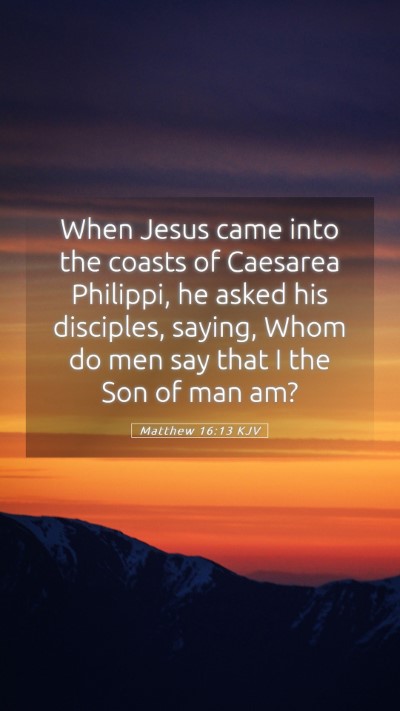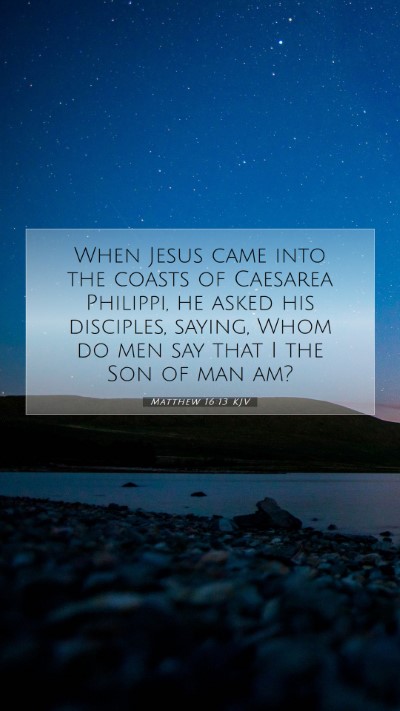Understanding Matthew 16:13
The Bible verse Matthew 16:13 states: "When Jesus came into the coasts of Caesarea Philippi, he asked his disciples, saying, Who do men say that I the Son of man am?" This verse marks a significant moment in the ministry of Jesus, where He begins to reveal His identity to His disciples and addresses their understanding of His mission.
Contextual Background
Matthew 16:13 occurs in a specific historical and cultural context. Jesus' ministry was gaining attention, and the interest in His identity was prevalent among the people. This inquiry by Jesus comes shortly after a series of miracles and teachings that have demonstrated His authority and power.
Verse Analysis
The inquiry "Who do men say that I the Son of man am?" serves multiple purposes:
- Self-Revelation: Jesus seeks to know how He is perceived by others, paving the way for a deeper revelation of His true nature.
- Discipleship Education: This question serves as a teaching moment for the disciples, encouraging them to articulate their beliefs and understandings.
- Challenge of Public Opinion: By asking about public perception, Jesus prompts the disciples to consider the many opinions circulating about Him.
Biblical Commentary Insights
From the commentaries of Matthew Henry, Albert Barnes, and Adam Clarke, we find profound insights regarding this passage:
Matthew Henry's Commentary
Henry emphasizes that this question reflects both the curiosity about Jesus and the necessity for disciples to recognize and affirm His divine identity. He notes the significance of being grounded in the truth of who Jesus is amidst varied opinions.
Albert Barnes' Commentary
Barnes draws attention to the title "Son of man," which signifies Jesus' humanity and links to Old Testament prophecies. He notes the implications of this title, stressing that it reflects both His humility and His authority as the Messiah.
Adam Clarke's Commentary
Clarke highlights the geographic location, Caesarea Philippi, as significant, suggesting that the setting emphasizes the contrast between worldly authority and the divine authority of Christ. He discusses how this question sets the stage for Peter's confession following the disciples' responses.
Significance and Application
The application of Matthew 16:13 can be reflected in several ways:
- Personal Reflection: Believers are challenged to consider their own understanding and perception of Jesus Christ.
- Community Discussion: This verse can foster discussions in Bible study groups about the nature of Christ and the diversity of opinions regarding His identity.
- Evangelism: Addressing how the world perceives Jesus aids in sharing the gospel effectively, as many may carry misconceptions about who He is.
Cross References
This verse can be linked to several important passages in the Bible that add depth to the understanding of Jesus' identity:
- Matthew 1:23 - The prophecy of the virgin birth indicating God's divine intervention.
- John 1:14 - The Word made flesh, affirming the intersection of divinity with humanity.
- Matthew 16:16 - Peter’s declaration of the Christ, showcasing the significance of personal faith.
- Isaiah 9:6 - A prophetic understanding of Jesus as Mighty God, emphasizing His divine authority.
- Luke 9:20 - Parallel account demonstrating the same inquiry into Christ's identity and the disciples’ responses.
Conclusion
Matthew 16:13 serves as a pivotal inquiry into the identity of Christ, calling for introspection among His followers and establishing a foundation for the recognition of His divine nature. Through this verse, believers are encouraged to actively engage with Scripture, fostering a deeper understanding of Jesus as both fully human and fully divine.


